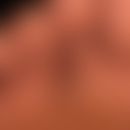Synonym(s)
DefinitionThis section has been translated automatically.
Rare form of dermatomyositis in children. In contrast to adult forms there is no association with malignant diseases.
ClassificationThis section has been translated automatically.
A clinical distinction is made between:
- acutely intermittent form
- chronic progressive form.
You might also be interested in
Occurrence/EpidemiologyThis section has been translated automatically.
EtiopathogenesisThis section has been translated automatically.
Unknown. Vasculitic etiopathogenesis and association with HLA-B8 are discussed. Previous (viral) infections are often suspected as triggers.
ManifestationThis section has been translated automatically.
In children, usually occurring before the age of 12. Frequency peaks in the 6th LJ and 10 LJ for girls and in the 6th LJ for boys. Girls are affected 2-5 times as often as boys (these figures must be verified).
ClinicThis section has been translated automatically.
- Frequent insidious onset with feeling of illness, fatigue, muscle weakness, skin rash, fever. Usually progresses over several months. In some cases, highly acute courses can also occur with initially high fever, strong general feeling of illness and muscle pain.
- Integument: S.u. Dermatomyositis. Initially mostly dry, scaly or inflammatory reddened plaques in the joint areas of the extremities. In 50% of patients calcinosis cutis, muscle contractures or palmoplantar hyperkeratosis are impressive. The occurrence of halo-naevi is rarer.
- Extracutaneous manifestations: Various organ systems are affected, including the gastrointestinal tract with motility disorders, hemorrhages, ulcerations and perforations as an expression of early vasculitis. Joints (arthralgias or arthritides in up to 2/3 of cases), heart and lungs can be affected, either directly (diffuse interstitial fibrosis, pneumonia) or as a result of severe muscle weakness. Mostly increasing muscle weakness in the proximal muscle groups of the upper and lower extremities.
LaboratoryThis section has been translated automatically.
S.u. Dermatomyositis.
CK and aldolase are more frequently elevated than in the adult form.
Non-specific inflammatory parameters such as BSG and CRP are often within the normal range.
ANA. positive in 20-25% of cases
TIF-1 antibody positive at 30%.
NXP-2 antibody at 25%.
Differential diagnosisThis section has been translated automatically.
General therapyThis section has been translated automatically.
Internal therapyThis section has been translated automatically.
S.u. Dermatomyositis. Cooperation with the pediatrician.
- During acute attacks of glucocorticoids such as prednisolone (e.g. Decortin) 1-2 mg/kg bw/day p.o. Slow reduction over weeks to months. In therapy-resistant cases, the use of azathioprine, methotrexate, Ciclosporin A, hydroxychloroquine is described as successful.
- Own successes were achieved with IVIG therapy.
- Aluminium hydroxide can be used to reduce calcinosis cutis. Circumscribed calcifications can be removed surgically.
Progression/forecastThis section has been translated automatically.
Inexpensive, with high rate of complete healing.
LiteratureThis section has been translated automatically.
- Bohan A (1977) Computer-assisted analysis of 153 patients with polymyositis and dermatomyositis. Medicine (Baltimore) 56:255-286
- Kobayashi I et al (2003) Interstitial lung disease associated with juvenile dermatomyositis: clinical features and efficacy of cyclosporin A. Rheumatology (Oxford) 42: 371-374
- Mendez EP et al (2003) US incidence of juvenile dermatomyositis, 1995-1998: results from the National Institute of Arthritis and Musculoskeletal and Skin Diseases Registry. Arthritis Rheum 49: 300-305
- Peloro TM et al (2001) Juvenile dermatomyositis: a retrospective review of a 30-year experience. J Am Acad Dermatol 45: 28-34
- Sallum AM et al (2002) Juvenile dermatomyositis: clinical, laboratory, histological, therapeutic and evolutionary parameters of 35 patients. Arq Neuropsiquiatr 60: 889-899
- Sallum AM, Marie SK et al (2004) Immunohistochemical analysis of adhesion molecule expression on muscle biopsy specimens from patients with juvenile dermatomyositis. J Rheumatol 31: 801-807
Schultz HY et al (2015) From pathogenesis, epidemiology, and genetics to definitions, diagnosis, and treatments of cutaneous lupus erythematosus and dermatomyositis: a report from the 3rd International Conference on Cutaneous Lupus Erythematosus (ICCLE) 2013 J Invest Dermatol 135:7-12
- Wargula JC (2003) Update on juvenile dermatomyositis: new advances in understanding its etiopathogenesis. Curr Opin Rheumatol 15: 595-601
- Zipitis CS et al (2004) Treatment approaches to juvenile dermatomyositis. Expert Opinion Pharmacother 5: 1509-1515
Incoming links (1)
Mi-2 antibodies;Outgoing links (17)
Adult dermatomyositis; Antinuclear antibodies; Azathioprine; Calcinosis cutis (overview); Ciclosporin a; C-reactive protein; Dermatomyositis (overview); Glucocorticosteroids systemic; Hydroxychloroquine; Ivig; ... Show allDisclaimer
Please ask your physician for a reliable diagnosis. This website is only meant as a reference.






